Castor and Pollux › Cave of Letters › Color in Ancient Egypt » Origins and History
Articles and Definitions › Contents
- Castor and Pollux › Who Was
- Cave of Letters › Origins
- Color in Ancient Egypt › Origins
Ancient civilizations › Historical places, and their characters
Castor and Pollux › Who Was
Definition and Origins
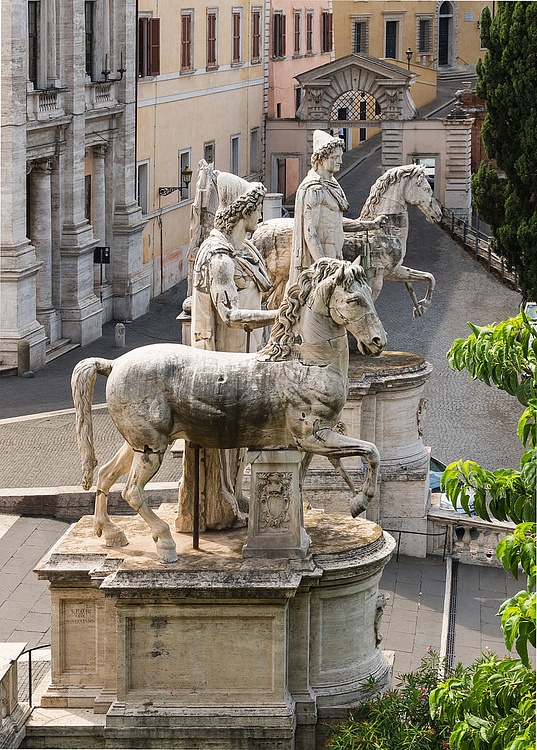
Castor and Pollux (the Dioscuri ) are figures from Greek and Roman mythology considered the twin sons of Zeus or Jupiter. Semi-divine figures, they were credited with the role of saving those in trouble at sea or in grave danger in war and were particularly associated with horses and sports. The brothers were linked with Sparta especially and had their own temples in Athens and on Delos. The Dioscuri were the patrons of the Roman knights and played an important role in martial ceremonies into the imperial period.
NAMES & FAMILY
The original Greek name of the brothers was Kastor and Polydeukes, Latinised to Castor and Pollux. Together they are known as the Dioscuri from the original Greek form, the Dioskouroi, meaning 'youths of Zeus', as the great god was considered their immortal father after he disguised himself as a swan and seduced Leda. The twins were born from an egg in one of the many versions of the myth. Pollux was considered immortal whilst his brother was mortal as his human father was Tyndareus, the king of Sparta, who also slept with Leda on the same night, hence the confusion over the paternity of the twins. This also explains their other name, the Tyndaridae. Then again, in Homer ’s Iliad both are treated as dead, explaining their association with the Underworld. The matter is partially resolved in Homer's Odyssey where he explains that the twins alternated each day, one being alive, the other dead and then vice-versa the next day. This idea is also presented by Pindar who states that the twins shared their immortality and switched daily between Mt. Olympus and Hades.
MYTHOLOGICAL ADVENTURES
Castor and Pollux were involved in several famous episodes from Greek mythology. They accompanied Meleager on his Calydonian boar hunt and went with Jason and the other Argonauts on their successful search for the Golden Fleece. It was during this latter adventure that Pollux out-boxed the prodigiously strong Amycus, king of the Bebryces.
When their sister Helen was abducted by Theseus, the brothers brought her back to Sparta from Attica and took Aethra, Theseus' mother, for good measure. A final episode was when the brothers, initially on a cattle-rustling expedition, abducted Phoebe and Hilaeira, the daughters of Leucippus. They had to fight to keep their prizes, though, with the girls' cousins Idas and Lynceus, to whom the girls had been betrothed. Only Pollux survived the clash and, thus, the necessity to share his immortality with Castor is explained. The fight between the rival families is, perhaps, a mythological explanation for the real feud between long-time rivals Sparta and Messenia.
CASTOR & POLLUX PROTECTED WARRIORS & SAILORS, ESPECIALLY THOSE IN LIFE-THREATENING SITUATIONS WHEN THEY WOULD OFTEN APPEAR IN PERSON.
ASSOCIATIONS
The twins were considered the protectors of the home and hospitality, oaths, friendship, and sporting activities. Castor was held to be a skilled horse-tamer while Pollux possessed great boxing skills. Both were thought to protect warriors in battle and sailors at sea, especially those in life-threatening situations, and they would often appear in person at such times. At sea they were thought to appear in the form of St. Elmo's fire.
In Italy the cult of the twins went back to the mid-6th century BCE. For the Romans the twins were the offspring of Jupiter and Leda; both were particularly associated with cavalry and Castor was adopted by the Roman knights ( equites ) for their patron.In addition, the twin brothers were represented in the constellation Gemini. Other associations were the dokana symbol (two vertical wooden posts connected by two horizontal beams), pairs of amphorae, snakes, and bossed shields.
WORSHIP & TEMPLES
Castor and Pollux were important across Greece but especially the Peloponnese. Sparta, where warfare was fundamental to the culture, claimed the twins were from the city, but they were also popular in Lokris and Athens. In the latter city they were known by the name Anakes and given a temple on the slopes of the acropolis which was used as a mustering point for hoplites.
A Doric temple at Agrigento on Sicily has traditionally been linked to the Dioscuri, but there is no direct evidence. Built between 480 and 460 BCE, it originally had 6 columns on each facade and 13 along the longer sides. More definitely, the Dioscuri had a sanctuary dedicated to them on the island of Delos.
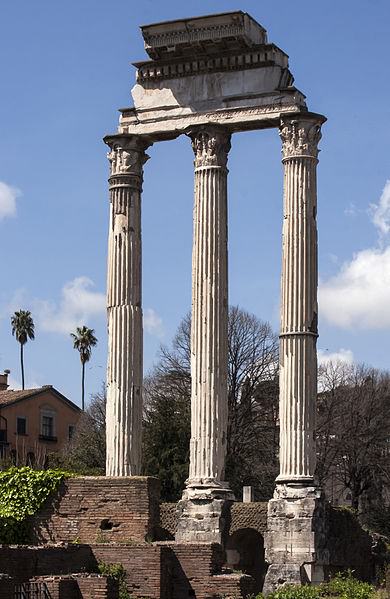
Temple of Castor & Pollux
A temple of the Dioscuri was dedicated in the Forum of Rome by the Roman general Aulus Postumius following his victory over the Latins at the Battle of Lake Regillus in 484 BCE. During the battle two young men riding white horses were said to have appeared and guided the Romans to victory and then were seen again after the battle watering their horses at the Juturna Spring in Rome, hence the subsequent dedication to the famous cavalry twins and choice of location for the temple next to the fountain in the Forum. Every 15th of July the temple was the focus of a cavalry parade - the transvectio - of 5,000 men led by two impersonators of the heroes who commemorated the victory at Regillus.
After a fire destroyed the original, a new temple was built on the site in the 1st century BCE. The temple was a massive structure measuring 32 x 50 m and reached a height of almost 19 m. The facades had 8 Corinthian columns whilst the sides each had 11. The temple served as the office of weights and measures with an additional function as a bank. Three of its tall columns still stand today. At the same time, Augustus made the cult of Castor and Pollux an official imperial one, associating his heirs with the twins, and initiated a new feast day for the pair on the 27th of January.
Rome also had a temple dedicated to the Dioscuri in the Circus Flaminius, and there were temples at Assisi, Cori, Naples, and Tusculum. Tables of food were set out at such temples ( theoxenia ), as they were in private homes too, and offered to guests and travellers to gain favour from the twins in return for their protection.
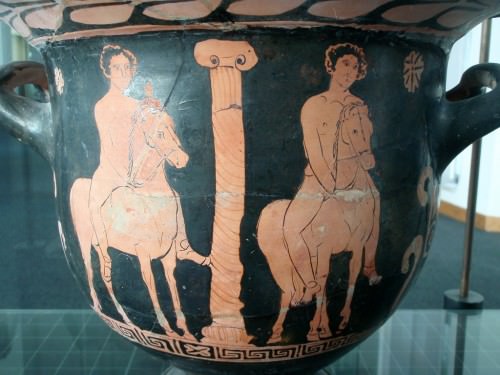
Castor and Pollux
REPRESENTATION IN ART
The Dioscuri appeared in the relief sculpture decorating the treasury of the Sicyonians at Delphi, which was built in the 6th century BCE. The sculpture showed episodes from the Argonaut and Leucippus stories. The twins appeared on Attic black-figure pottery, typically in scenes with Leda, the abduction of Leucippus' daughters, and offering tables for guests and travellers. Many Roman coins depicted the pair as cavalry riders. In figure sculpture, the twins proudly stand today either side of the steps leading up to the Capitoline Museums in Rome. Each figure stands by his horse, and although much restored in the 16th century CE, they incorporate fragments found at the site of the Temple of Castor and Pollux in the Forum.
Cave of Letters › Origins
Definition and Origins

Everyone is aware of the Dead Sea Scrolls, but few realise that these were just one find in a region which continues to yield hundreds of finds significant to our understanding of lives in the first centuries CE, the Jewish revolts and the relationships between the peoples involved in the area. The Cave of Letters is one such site in Israel which has yielded a large number of papyrus letters and documents.
DISCOVERY
The Cave of Letters was discovered in Israel in the early 1960s CE and was excavated by the famed Israeli archaeologist Yigael Yadin from 1960-1961 CE. Yadin devoted himself to research and archaeology upon leaving the military and received the Israel prize in Jewish studies for his doctoral thesis on the translation of the Dead Sea scrolls. Apart from the Cave of Letters, Yadin excavated numerous important sites in the region which included Tel Megiddo, Masada, the Qumran Caves and Hazor. Yadin discovered the cave when he launched an urgent search of the dead sea caves in order to rescue artefacts of historical significance before they were looted by increasing numbers of treasure hunters in the region. The cave may be one of the 64 locations which were inscribed on a copper scroll found in another cave near the Dead Sea village of Qumran. This is believed to be due to the similarities in location and shape of the cave entrances as two columns in addition to the placement of bronze artefacts and stone vessels in the cave which are also mentioned on the scroll.
ARCHAEOLOGICAL EXCAVATIONS
The Cave of Letters was found above a canyon called Nahal Hever. The cave is located in the area of the Dead Sea in the Judean desert and can only be assessed via a 50 ft (15.24 m) climb up to the cave's entrance. During the 1960-61 CE excavations, Yadin uncovered a number of human skulls and bones and common objects of daily life alongside what he believed to be bronze ritual items. Yadin's team also uncovered clusters of papyrus letters which made up the largest cache of ancient personal correspondence and documents ever found in Israel. These letters are slowly being published, a process yet to be completed. Among the letters include correspondence from Bar Kokhba, a messianic leader of the third Jewish revolt against the Romans in the second century CE. Judea was part of the Roman empire but the Jewish people lived uncomfortably with their Roman rulers as a subject nation. Among the documents in the Cave of Letters were found military orders signed by Bar Kokhba as Shimon Bar Kokhba, Simon son of a star.
SURPRISINGLY TO SOME SCHOLARS THE LETTERS HAVE QUITE A HARSH TONE & INCLUDE THREATENING LETTERS TO YEHONATAN WHO WAS THE LEADER OF EN GEDDI.
CONTENTS OF THE LETTERS
Surprisingly to some scholars the letters have quite a harsh tone and include threatening letters to Yehonatan who was the leader of En Geddi. In 2000-2001 CE the archaeologist and Professor of Jewish History, Richard Freund, from the University of Hartford, led a team under the John and Carol Merrill Expedition to find out more about the Cave of Letters. On returning to the cave with an international team of archaeologists and scholars, Freund uncovered new evidence about the use of the cave and located a large number of new artefacts. Freund explains that the Cave of Letters is a massive cave with two openings in the sheer cliff wall with three internal chambers connected by narrow passageways with the cavern complex cutting more than 300 yards (274 m) deep into the cliff-side. Freund had the chance to explore new areas to excavate which Yadin didn't get a chance to. Yadin was unable to explore beneath the thick layer of rubble on the cave floor caused by centuries of earthquakes.In some areas the rubble was as thick at 15ft (4.57 m). Freund also had access to ground-penetrating radar and electrical resistivity tomography which allowed him to excavate and survey beyond Yadin's means. Freund and Yadin's excavations turned up artefacts that are significant to the history of the relationship between Judaism and Christianity and the politics of the modern Middle East.
One of the most significant corpuses of letters found in the cave are the personal documents of a Jewish woman who lived in the port town of Maoza. This woman was named Babatha. The documents give a vivid picture of the life of an upper-middle class Jewish woman during the second century CE. They date from around 96-134 CE and give examples of Roman bureaucracy and legal systems by including legal contracts concerning marriage, property transfers and guardianship. They show that Babatha was born around 104 CE and inherited her father's date palm orchard. She married for the first time in 124 CE and was widowed with a son named Jesus. She remarried in 125 CE to a man named Judah who already had another wife and a teenage daughter. There are also loan documents showing that Judah borrowed money from Babatha who was clearly in control of her own money. She got this money back upon Judah's death in the form of his estates. Other documents in the Babatha archive include those concerning the guardianship of her son and a dispute between her and Judah's first wife Miriam over Judah's estates.
USE OF THE CAVE
The use of the Cave of Letters is still under some debate but the artefacts are revealing. The most common theory is that the cave was used as a hideaway by Jewish refugees who were escaping oppressive Roman rule. Babatha would have been in the area in 132 CE when Bar Kokhba was performing his revolt. It is possibly that she fled or was killed as the documents in the cave were never recovered and were found alongside 20 skeletons which suggest that she or others perished while taking refuge in the cave. What is interesting about the skeletal remains is the complete lack of signs for violent trauma suggesting that they died of starvation. The cave being used as a refuge is also suggested by signs of animals and cooking preparations including a piece of a circular oven. Freund found a number of items indicative of everyday life including rope and papyrus fragments, fabrics, a wooden comb, signs of living areas and a child's sandal. The sandal is particularly significant because evidence of women and children in the area is rare.
The Cave of Letters also provides direct evidence of Bar Kokhba's early triumphs supposedly with a Bar Kokhba coin found in the AB passage. This is one of eight coins found in the cave. The inscription on the coin reads 'for the freedom of Jerusalem '.Clearly the Cave of Letters is a trove of information and significance.
Color in Ancient Egypt › Origins
Ancient Civilizations
The ancient Egyptians had a great appreciation for life which is clearly depicted through their art. Images of people enjoying themselves - whether in this life or the next - are as plentiful as those most often seen of the gods or funerary rituals. The early Egyptologists who first encountered the culture focused their attention on the many examples of funerary art found in tombs and concluded that Egyptian culture was death-obsessed when, in reality, the ancient Egyptians were wholly absorbed in living life to its fullest.
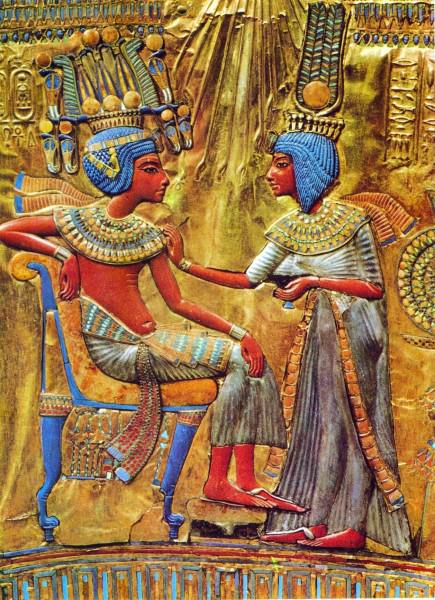
Tutankhamun & Ankhsenamun
Egyptians decorated their homes, gardens, palaces, and tombs with impressive works of art which reflected their appreciation for all that the gods had given them and accented these depictions with vibrant colors. The palace of Amenhotep III (1386-1353 BCE) at Malkata was brightly painted, the outer walls of white and the interiors of blue, yellow, and green, with murals and other ornamentation throughout. These colors were not chosen randomly but each had a very specific symbolism for the Egyptians and were used to convey that significance. Egyptologist Rosalie David comments on this:
Colour was regarded as an integral element of all art representations, including wall -scenes, statuary, tombgoods, and jewelry, and the magical qualities of a specific color were believed to become an integral part of any object to which it was added (176).
EACH COLOR HAD ITS OWN PARTICULAR SYMBOLISM & WAS CREATED FROM ELEMENTS FOUND IN NATURE.
Color in ancient Egypt was used not only in realistic representations of scenes from every life but to illustrate the heavenly realms of the gods, the afterlife, and the stories and histories of the deities of the Egyptian pantheon. Each color had its own particular symbolism and was created from elements found in nature. Egyptologist Margaret Bunson writes how "artisans began to observe the natural occurrence of colors in their surroundings and pulverized various oxides and other materials to develop the hues they desired" (54). This process of Egyptian artists creating colors for their art dates to the Early DynasticPeriod (c. 3150-c. 2613 BCE) but becomes more pronounced during the time of the Old Kingdom (c. 2613-2181 BCE). From the Old Kingdom until the country was annexed by Rome after 30 BCE, color was an important component of every work of art fashioned by the Egyptians.
REALISM IN COLOR
Each color was created by mixing various naturally occurring elements and each became standardized in time in order to ensure a uniformity in art work. An Egyptian male, for example, was always depicted with a reddish-brown skin which was achieved by mixing a certain amount of the standard red paint recipe with standard brown. Variations in the mix would occur in different eras but, overall, remained more or less the same. This color for the male's skin was chosen for realism in the piece, in order to symbolize the outdoor life of most males, while Egyptian women were painted with lighter skin (using yellow and white mixes) since they spent more time indoors.
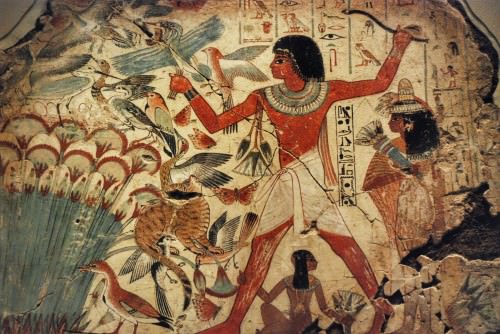
Egyptian Hunting in the Marshes
The gods were typically represented with gold skin, reflecting the belief that gods did, in fact, have gold skin. An exception to this is the god Osiris who is almost always shown with green or black skin symbolizing fertility, regeneration, and the underworld. Osiris was murdered, returned to life by Isis, and then descended to rule over the land of the dead; the colors used in his depictions all symbolize aspects of his story. Whether a scene shows a man and his wife at dinner or the gods in the solar barge, each color used had to accurately represent the various themes of these events.
COLOR CREATION & SYMBOLISM
The different colors below are listed with their Egyptian name following, the materials used in creating them, and what they symbolized. The definitions follow the work of Richard H. Wilkinson in his Symbolism & Magic in Egyptian Art and Margaret Bunson's Encyclopedia of Ancient Egypt, supplemented by other works.
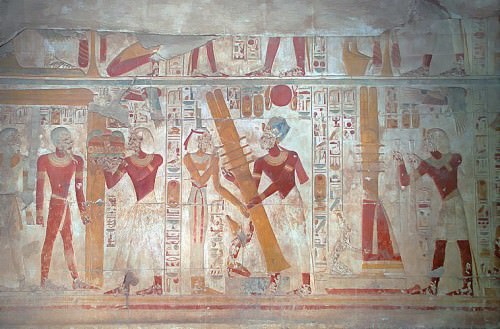
Djed Pillars, Hall of Osiris, Abydos
Red ( desher ) - made from oxidized iron and red ocher, used to create flesh tones and symbolizing life but also evil and destruction. Red was associated with both fire and blood and so symbolized vitality and energy but could also be used to accentuate a certain danger or define a destructive deity. The god Set, for example, who murdered Osiris and brought chaos to Egypt at the beginning of time, was always represented with a red face or red hair or completely in red. One also sees this pattern in written work where the color red is sometimes used to signify a dangerous character or aspect in a story. In wall paintings and tomb scenes red must be carefully interpreted within the context of the scene. Although it was frequently used for emphasis of danger or even evil, it is also as commonly seen symbolizing life or a higher being (as in depictions of the Eye of Ra) or elevated status as in the Red Crown of Lower Egypt.
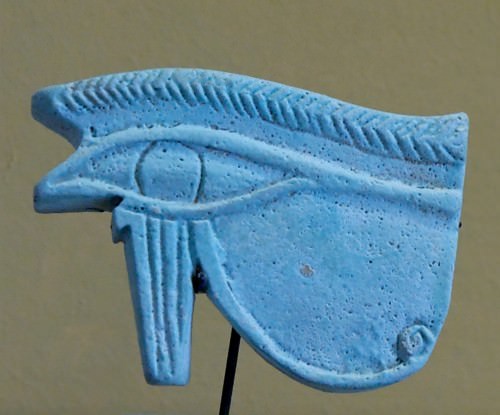
Eye of Horus
Blue ( irtiu and khesbedj ) - one of the most popular colors, commonly referred to as "Egyptian Blue", made from copper and iron oxides with silica and calcium, symbolizing fertility, birth, rebirth and life and usually used to depict water and the heavens.Wilkinson writes, "by the same token, blue could signify the river Nile and its associated crops, offerings, and fertility, and many of the so-called `fecundity' figures which represent the river's bounty are of this hue" (107). Statues and depictions of the god Thoth are routinely blue, blue-green, or have some aspect of blue in them linking the god of wisdom with the life-giving heavens. Blue also symbolized protection. Fertility amulets of the protector-god Bes were often blue as were the tattoos women would wear of Bes or diamond-shaped patterns on their lower abdomen, back, and thighs. It is thought these tattoos were worn as amulets to protect women during pregnancy and childbirth.
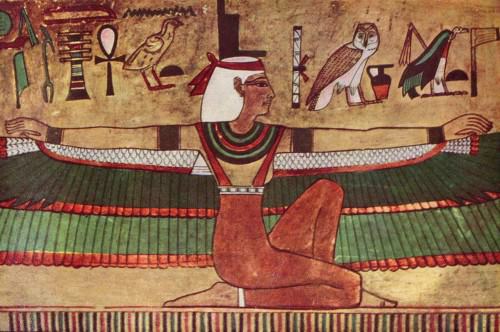
Isis
Yellow ( khenet and kenit ) - made from ocher and oxides originally but, from the New Kingdom (c. 1570-1069 BCE) was mixed from arsenic trisulphide and symbolizing the sun and eternity. Yellow was darkened for the golden flesh-color of the gods or lightened with white to suggest purity or some sacred aspect of a character or object. Isis, for example, is always depicted with gold skin in a white dress but, sometimes, her dress is a light yellow to emphasize her eternal aspect in a scene or story. It is thought that priests and priestesses of the gods of Egypt would sometimes dress as their deities and Wilkinson suggests that priests of the god Anubis would color their skins yellow on certain occassions to "become" the god for the event.Although Anubis was traditionally represented as black-skinned, there are a number of texts depicting him with the golden hue of the other gods.

Egyptian Afterlife
Green ( wadj ) - mixed from malachite, a copper mineral, and symbolizing goodness, growth, life, the afterlife, and resurrection. The Egyptian afterlife was known as The Field of Reeds and, in some eras, as The Field of Malachite and was always associated with the color green. Wilkinson writes how green was "naturally a symbol of growing things and of life itself" and goes on to point out how, in ancient Egypt, "to do `green things' was a euphemism for positive, life-producing, behavior in contrast to `red things' which symbolized evil" (108). Green is the color of the dying and reviving god Osiris and also of the Eye of Horus, one of the most sacred objects in Egyptian mythology. In early tomb paintings the spirit of the deceased is shown as white but, later, as green to associate the dead with the eternal Osiris. In keeping with the symbolism of ressurection, green is also often used to depict the goddess Hathor, Lady of the Sycamore. Hathor was closely associated with the Sycamore tree, with renewal, transformation, and rebirth. Mummies of tattooed women suggest the ink could have been green, blue, or black and tattoos have been linked with the worship of Hathor.
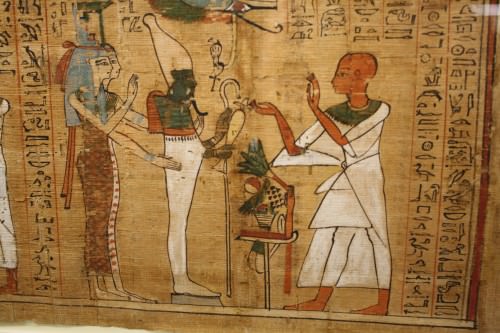
Book of the Dead of Aaneru
White ( hedj and shesep ) - made from chalk mixed with gypsum, often employed as a lightener for other hues, and symbolizing purity, sacredness, cleanliness, and clarity. White was the color of Egyptian clothing and so associated with daily life but was frequently employed in artistic pieces to symbolize the transcendent nature of life as well. Priests always wore white and so did temple attendants and temple personnel taking part in a festival or ritual. The objects used in rituals (such as bowls, plates, altars, tables) were made of white alabaster. White, like the other colors, was used realistically in depicting clothing and objects of that color in real life but frequently is employed to highlight the importance of some aspect of a painting;in some cases, it did both these things. The White Crown of Upper Egypt, for example, is routinely referred to as white - and so is realistically depicted - but also symbolized the close connection to the gods enjoyed by the king - and so symbolically represents purity and the sacred.
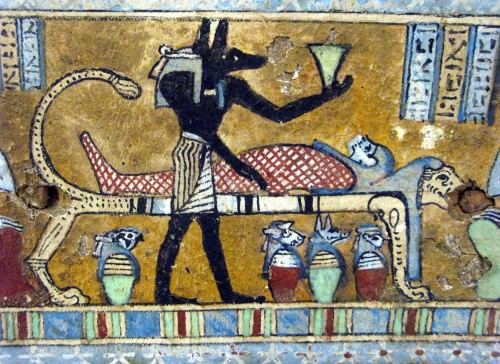
Anubis, Egyptian Sarcophagus
Black ( kem ) - made from carbon, ground charcoal, mixed with water and sometimes burnt animal bones, symbolized death, darkness, the underworld, as well as life, birth, and resurrection. Wilkinson writes, "the symbolic association of the color with life and fertility may well have originated in the fertile black silt deposited by the Nile in its annual flooding and Osiris - god of the Nile and of the underworld - was thus frequently depicted with black skin" (109). Black and green are often used interchangably in Egyptian art, in fact, as symbols of life. Statues of the gods were frequently carved from black stone but, just as often, from green. Although black was associated with death it had no connotation of evil - which was represented by red - and, frequently appears along with green, or instead of green, in depictions of the afterlife. Anubis, the god who guides the dead to the hall of judgment and is present at the weighing of the soul's heart, is almost always depicted as a black figure as is Bastet, goddess of women, one of the most popular deities in all of Egypt. Tattoos of Bes were done in black ink and images of the afterlife frequently make use of a black background to not only accentuate the gold and white of the foreground but also symbolize the concept of rebirth.
BLACK SYMBOLIZED DEATH, DARKNESS, THE UNDERWORLD, AS WELL AS LIFE, BIRTH, & RESURRECTION.
These basic colors were often mixed, diluted, or otherwise combined to create colors such as purple, pink, teal, gold, silver, and other hues. Artists were not bound by the minerals they mixed their paints from but only by their imaginations and talent in creating the colors they needed to tell their stories.
COLORS IN CONTEXT
Aesthetic considerations were of great importance to the Egyptians. Art and architecture is charactized by symmetry and even their writing system, the hieroglyphics, were set down in accordance with visual beauty as an integral aspect of their function.In reading hieroglyphics, one understands the meaning by noting which direction the figures are facing; if they face left, then one reads to the left and, if up or down or right, in whichever of those directions. The direction of the figures provides the context of the message and so provides a means of understanding what it being said.
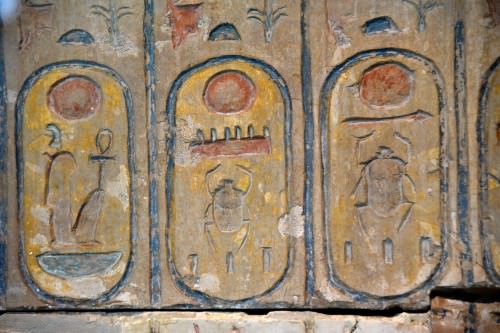
King-list of Egypt, Detail of the 18th Dynasty
In the same way, color in Egyptian art must be interpreted in context. In a certain painting, red might symbolize evil or destruction but the color should not always instantly be interpreted along those lines. Black is a color often misinterpreted in Egyptian art because of the modern-day association of black with evil. Images of Tutankhamun, found in his tomb, sometimes depict him with black skin and these were originally associated with death and grief by the early archaeologists interpreting the finds; although the association with death would be correct, and grief did accompany the loss of anyone in ancient Egypt as today, a proper interpretation would be the association of Tutankhamun in death with Osiris and the concept of rebirth and resurrection.
White retains the same meaning in the present day that it had for the ancient Egyptians but, as noted, must also be interpreted in context. The white dress of Isis would signify purity and the sacred yet the white skirt of Set would simply be a representation of how a male Egyptian dressed. Recognizing the symbolism of Egyptian colors, however, and why they were most commonly used, allows one a greater appreciation of Egyptian art and a clearer understanding of the message the ancient artist was trying to convey.
LICENSE
Article based on information obtained from these sources:with permission from the Website Ancient History Encyclopedia
Content is available under License Creative Commons: Attribution-NonCommercial-ShareAlike 3.0 Unported. CC-BY-NC-SA License